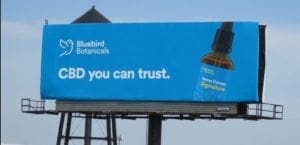
By Kerry Yoakum, Vice President of Government Affairs, OAAA
If CVS is selling cannabidiol products over the counter and Carl’s Jr has CBD burgers in Denver, then it must be okay to advertise, right?
The promotion of new CBD products raises complex issues. In this report, I’ll explain CBD, how it is different than marijuana, and break down the steps toward advertising compliance.
A large part of the cannabis industry’s growth can be attributed to the increasing popularity of products that contain CBD. CBD, short for cannabidiol, is one of the hundreds of compounds found in the cannabis plant. The potential it has shown in helping with pain, seizures, and anxiety has made it a popular alternative for medical and recreational marijuana consumers.
The most commonly used form of CBD is CBD oil. Combining CBD extract with a carrier oil like coconut oil, it can be ingested or vaped. But because marijuana legalization is still in a murky state, both federal and state laws continue to grapple with the legality of CBD oil. It is important to understand the difference of CBD derived from hemp and CBD derived from marijuana. Marijuana and hemp are both members of the cannabis family, so they do share a lot of characteristics. There is, however, a crucial difference between the two – the amount of psychoactive Tetrahydrocannabinol (THC) each plant produces. While marijuana can contain up to 30 percent THC, hemp contains no more than 0.3 percent THC. In other words, marijuana can get you really high, while hemp has such a low amount of THC, that it would be impossible to get high off it.
Thirty-three states and the District of Columbia currently have passed laws broadly legalizing marijuana in some form. The District of Columbia and 10 states — Alaska, California, Colorado, Maine, Massachusetts, Michigan, Nevada, Oregon, Vermont, and Washington — have adopted the most expansive laws legalizing marijuana for recreational use.
Despite the many states that have legalized some or all forms of marijuana, for decades, federal law did not differentiate hemp from other cannabis plants, all of which were effectively made illegal in 1937 under the Marijuana Tax Act and formally made illegal in 1970 under the Controlled Substances Act — the latter banned cannabis of any kind.
This changed in 2014 when Congress approved the Farm Bill, which allowed pilot programs to study hemp. The 2018 Farm Bill went further and allows hemp cultivation broadly, not simply pilot programs for studying market interest in hemp-derived products. It explicitly allows the transfer of hemp-derived products across state lines for commercial or other purposes. It also puts no restrictions on the sale, transport, or possession of hemp-derived products, so long as those items are produced in a manner consistent with the law.
However, the 2018 Farm Bill does not create a completely free system in which individuals or businesses can grow hemp whenever and wherever they want. There are numerous restrictions. First, as noted above, hemp cannot contain more than 0.3 percent THC. Any cannabis plant that contains more than 0.3 percent THC would not be considered hemp under federal law and would thus be legally protected under this new legislation.
Second, there will be significant, shared state-federal regulatory power over hemp cultivation and production. State departments of agriculture must consult with the state’s governor and chief law enforcement officer to devise a plan that must be submitted to the Secretary of the US Department of Agriculture (USDA). A state’s plan to license and regulate hemp can only commence once the Secretary of USDA approves that state’s plan. In states opting not to devise a hemp regulatory program, USDA will construct a regulatory program under which hemp cultivators in those states must apply for licenses and comply with a federally run program. This system of shared regulatory programming is similar to options states had in other policy areas such as health insurance marketplaces under the Affordable Care Act (ACA), or workplace safety plans under OSHA—both of which had federally-run systems for states opting not to set up their own systems.
Third, the law outlines actions that are considered violations of federal hemp law (including such activities as cultivating without a license or producing cannabis with more than 0.3 percent THC). The law details possible punishments for such violations, pathways for violators to become compliant, and even which activities qualify as felonies under the law, such as repeat offenses.
 So, is it legal to advertise CBD products on OOH displays?
So, is it legal to advertise CBD products on OOH displays?
The 2018 Farm Bill essentially legalized industrial hemp and hemp-derived CBD oils, but the law requires the establishment of a regulatory framework that is not yet in place in all states. Once this happens in your state, the federal government should be fine with it being sold at the state level, if the states regulate those sales.
Currently, hemp-derived CBD is operating within a patchwork of regulations that vary by cities and states. In New York City, regulators are prohibiting outlets to sell CBD-infused food and beverages, threatening them with fines. Other states like Ohio and California are taking similar action. Maine’s governor, on the other hand, signed an emergency bill in late March allowing CBD in food products after state inspectors warned stores to pull them from shelves earlier in the year. Big players like CVS and Walgreens are selling skin creams and lotions with hemp-based CBD, and the FDA hasn’t specifically expressed concern. However, others are “rolling the dice” advertising and selling hemp-derived CBD-infused foods, drinks, and supplements as CBD isn’t allowed in foods.
Additionally, if the products must be legitimate hemp-based CBD oils, they cannot have the chemical THC in them. Because marijuana remains illegal federally, OOH companies need to take precautions not to run advertising for CBD oil derived from marijuana, as opposed to hemp.
Also, CBD oil proponents often advocate the health benefits of their product, but health claims in advertising are closely scrutinized by the Federal Trade Commission (FTC) and, to some extent, the Food and Drug Administration (FDA). If OOH companies run CBD oil advertising that makes health or medical claims, they should make sure there is evidence to support those claims.
In short:
- Know your state regulations.
- Make sure the CBD product is hemp-derived, not marijuana derived.
- Avoid advertising hemp-derived CBD-infused foods, drinks, and supplements.
- Make sure there is evidence to support health or medical product claims.
- Establish exclusionary zones that prohibit advertisements of products illegal for sale to minors that are intended to be read from, at least 500 feet of, elementary and secondary schools, public playgrounds, and established places of worship.
- Avoid showing consumption in advertising.
[wpforms id=”9787″]
Paid Advertisement

















